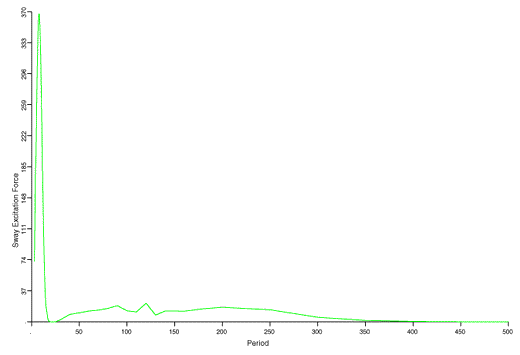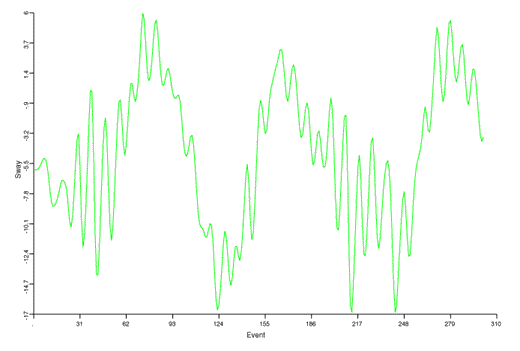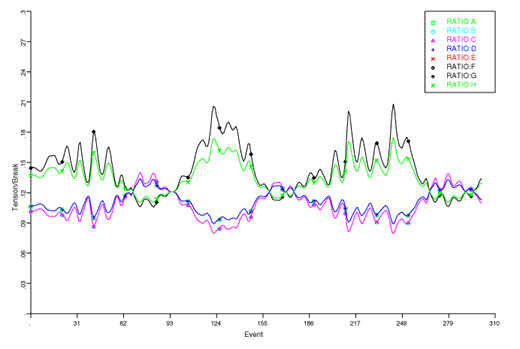- Overview of Mooring
- Multi-Point Mooring
- Mooring Line Fatigue
- Automated Tanker Mooring
- Manual Tanker Mooring
- Side by Side Tanker Mooring
- Free Standing Riser
Overview of Mooring:
Here, by Mooring, we mean analyzing a body (or collection of bodies) which are connected to the sea floor by a system of catenary lines. The general purpose of the lines is to keep the body in reasonable proximity of some target location. There are two aspects to this problem. The forces which the lines exert on the body, and the forces which the environment exerts on the body. Let us begin by looking at the connection forces (restraining force due to a line) due to a single line.

- The horizontal force in the line (the restoring force),
- The tension in the line (the force which breaks the line), and
- The derivative of the horizontal force.
All of these curves are plotted as a function of the horizontal distance between the anchor (the end on the bottom) and the fairlead (the end connected to the ship). The tension must always be greater than the horizontal component. Although it is hard to see in this picture, at the beginning, the tension and horizontal differ by a constant which is the weight of a segment of line as long as the water depth. This relationship remains in effect so long as there is line laying on the bottom. Once all line is off the bottom, the tension gets closer to the horizontal.
DH/DX is plotted because it is quite useful. Suppose that we were holding the body with the single line above and that a single force was acting on it. One can easily find the equilibrium position from the above plot. You simply find where the horizontal force is equal the applied force and you know that the equilibrium position will be this distance from the anchor. If a second force were applied to the body, it would move away from the first position an amount given by the force divided by DH/DX. In other words, DH/DX is a measure of the stiffness of the line as a function of distance from the anchor. If we are interested in keeping the body from moving very far, we need a large DH/DX. Now notice that for most of the plot DH/DX is quite small. In this region a small change in force will produce large changes in position. This is not good from a station keeping point of view. Unfortunately, here we have no real control over where we "work", the position is determined by the external force alone.
For this reason, if one wants to stay close to a given position, he makes lines work in pairs. Suppose that we have two of the lines above, but in the opposite direction. Now, by controlling the distance of each to their anchor, we have zero net force on the body but each line has a "pretension". Now, we can pick the pretension so that we have a large DH/DX whatever the environment. In essence, we have solved the problem of wandering great distances with small applied forces by the use of two lines and a pretension. The greater the pretension, the stiffer the system becomes. Notice, however, that as DH/DX increases, so does the tension. We cannot have such a large pretension that for a small movement, or the line breaks.
The following figure shows the net result of using 4 pair (8 lines total).

Up until now we have concentrated on the restoring force - how about the excitation. Here, we will group these into three categories:
- Static forces (current, wind, and a mean wave force),
- Direct wave forces (forces at the wave period), and
- Non wave period forces (wave drift and wind gusts)
In fact, we can also easily account for the direct wave forces. All we need to do is to include the stiffness of the mooring system in the frequency domain equations of motions and the total excursion will be the sum of the static and frequency domain motions. Knowing the position, we can back calculate the tensions. This procedure, however, has a large assumption built into it - that the true effect of the nonlinear mooring system can be approximated by its stiffness at the mean position.
Now, what can we do about the third type of excitation? First, let us look at the magnitude of force itself. This figure



In general, if we are serious about analyzing a mooring system, we need to perform an analysis which includes all three parts of the excitation. If, however, we have a very stiff system then it will not be susceptible to large period forcing and a simple frequency domain approach will suffice.
